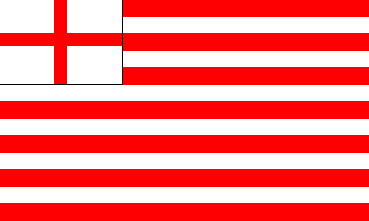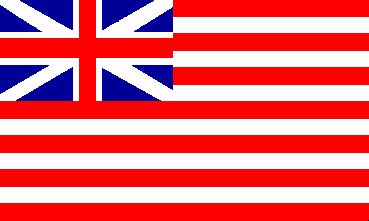18.7.06
QUE BANDERA DE BANDERA
East India Company & USA Flags
 Old Indian Navy Jack When the proclamation of 1674 authorized the red ensign for English merchant ships, the Honourable East India Company was restricted in 1676 to using their ensigns in eastern waters, and beyond St Helena in the Atlantic Ocean
Old Indian Navy Jack When the proclamation of 1674 authorized the red ensign for English merchant ships, the Honourable East India Company was restricted in 1676 to using their ensigns in eastern waters, and beyond St Helena in the Atlantic Ocean Wilson in Flags at Sea (1999) shows several ensigns of the Honourable East India Company with proportions that are roughly 3:5 and varying numbers of stripes. The first of these is the East India Company ensign until 1707. This is a thirteen-stripe version with the St George's Cross in the canton.
Wilson in Flags at Sea (1999) shows several ensigns of the Honourable East India Company with proportions that are roughly 3:5 and varying numbers of stripes. The first of these is the East India Company ensign until 1707. This is a thirteen-stripe version with the St George's Cross in the canton.On January 1, 1776, the Continental Army was reorganized in accordance with a Congressional resolution which placed American forces under George Washington's control. On that New Year's Day the Continental Army was laying siege to Boston which had been taken over by the British Army. Washington ordered the Grand Union flag hoisted above his base at Prospect Hill. It had 13 alternate red and white stripes and the British Union Jack in the upper left-hand corner (the canton).
"...The first flag of the colonists to have any resemblance to the present Stars and Stripes was the Grand Union Flag, sometimes referred to as the Congress Colors, the First Navy Ensign, and the Cambridge Flag. Its design consisted of 13 stripes, alternately red and white, representing the Thirteen Colonies, with a blue field in the upper left-hand corner bearing the red cross of St. George of England with the white cross of St. Andrew of Scotland.
As the flag of the Revolution it was used on many occasions. It was first flown by the ships of the Colonial Fleet on the Delaware River. On December 3, 1775, it was raised aboard Captain Esek Hopkin's flagship Alfred by John Paul Jones, then a Navy lieutenant. Later the flag was raised on the liberty pole at Prospect Hill, which was near George Washington's headquarters in Cambridge, Massachusetts.
It was our unofficial national flag on July 4, 1776, Independence Day; and it remained the unofficial national flag and ensign of the Navy until June 14, 1777, when the Continental Congress authorized the Stars and Stripes.
Interestingly, the Grand Union Flag also was the standard of the British East India Company. It was only by degrees that the Union Flag of Great Britain was discarded. The final breach between the Colonies and Great Britain brought about the removal of the British Union from the canton of our striped flag and the substitution of stars on a blue field..."
The origins of the US Flag, the Stars and Stripes has a connection to India. In this excerpt from R. Buckminster Fuller’s _Critical Path_(Copyright 1981 by R. Buckminster Fuller pp. xxi to xxii), Fuller writesBy pure chance I happened to uncover this popularly unknown episode of American history. Commissioned in 1970 by the Indian government to design new airports in Bombay, New Delhi, and Madras, I was visiting the grand palace of the British fortress in Madras, where the English first established themselves in India in 1600. There I saw a picture of Queen Elizabeth I and the flag of the East India Company of 1600 A.D., with its thirteen red and white horizontal stripes and its superimposed crosses in the upper corner. What astonished me was that this flag (which seemed to be the American flag) was apparently being used in 1600 A.D., 175 years before the American Revolution Displayed on the stairway landing wall together with the portrait of Queen Elizabeth I painted on canvas, the flag was paint- ed on the wall itself, as was the seal of the East India Company.
